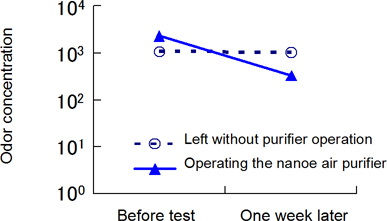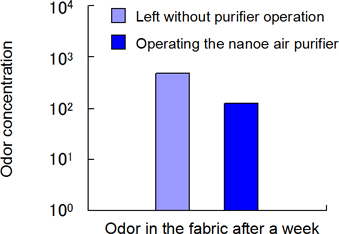May 09, 2012
Press Release
Panasonic Verifies the Deodorizing Effects of Air Purifiers with 'nanoe™' Electrostatic Atomized Water Particles on Pet Odors
Osaka, Japan - Panasonic Corporation today announced that it has verified the deodorizing effects of air purifiers equipped with a generator of nanoe™, nano-sized electrostatic atomized particles produced by applying high voltage to water, in actual pet shops under harsh conditions where pets continually emit odors. This verification was achieved through collaboration with Professor Megumi Mitsuda, Director of the Odor Research Center, School of Informatics, Daido University.
Japan is now in the midst of an unprecedented pet boom. A public opinion survey shows that 34.3%(*1) of respondents have a pet, and other research shows that 72%(*2) of the pet owner respondents keep their pets indoors. As pets live with their owners in the same space, odor problems have come to the surface(*3).
Getting full cooperation from two pet shops, Panasonic Ecology Systems Co., Ltd., a Panasonic group company, and Daido University conducted joint research and verified that air purifiers equipped with a generator of nanoe™ can remove odors from the air and fabric even under harsh conditions.
The Company will continue to develop advanced products to improve indoor air quality (IAQ)(*4), aiming to contribute to provision of healthy and comfortable living spaces and to the reduction of CO2 emissions.
The research results will be presented at the 36th Human Environment System Symposium (Nagoya) held in Daido University on December 1 and 2, 2012.
| • Two pet shops | : | One in Komaki City, Aichi Pref. and the other in Ginan Town, Hashima Gun, Gifu Pref. |
| • Odor analysis | : | Odor Research Center, School of Informatics, Daido University, Daido Gakuen |
■ Verification method
In the cage room at the back of each pet shop, odor concentrations(*5) in the air and fabric after a week of operating nanoe™ air purifiers and those after being left for a week without operating the purifiers were compared.
■ Verification results
The verification results show that the pet odor concentration in the air can be reduced to 14.4% of that before operating the nanoe™ air purifiers (Efficiency of deodorization: 85.6%). The pet odor concentration in the fabric can be reduced to 25.7% of that in the fabric left without operating the air purifiers (Prevention efficiency: 74.3%).
http://www8.cao.go.jp/survey/h22/h22-doubutu/zh/z03.html (Apr. 23, 2012)
https://www.fuji-keizai.co.jp/market/11036.html (Apr. 23, 2012)
http://www.anicom-sompo.co.jp/company/news/news_0100129.html (Apr. 23, 2012)
■ Details of the verification
Air purifiers equipped with a generator of nanoe™, nano-sized electrostatic atomized particles, were operated in the cage room of pet shops to verify the deodorizing effects on pet odors in the air and the effects of preventing pet odors from being absorbed by fabric.
● Equipment tested: Air purifiers equipped with a nanoe™ generator (F-VXF70)
● Verification method:
| • Test space: | Approx. 28 m3 pet cage room (with 12 dogs and one cat on average) | |
| • Operation method: | Two purifiers were installed in the test space and operated for a week. | |
| • Evaluation items: | (1) | Odor in the air: The odor sample (air) was taken on the first and last days, and the odor concentrations were measured by triangle odor bag method(*6). |
| (2) | Odor absorbed by fabric: The concentrations of odor desorbed from a fabric (towel) before being placed in the test space and from a fabric (towel) left in the space until the last day were measured by triangle odor bag method. | |
● Verification results
<Pet odor in the air>

| Odor concentration | Efficiency of deodorization |
||
|---|---|---|---|
| Before test | One week later |
||
| Left without purifier operation | 1045 | 1000 | 4.3% |
| Operating the nanoe™ air purifier | 2250 | 325 | 85.6% |
* The results show averages of multiple test data values.
| Efficiency of deodorization (%: Calculated based on the odor concentration) = (Before installing the purifier - After installing the purifier) / (Before installing the purifier) x 100 |
<Pet odor absorbed by fabric>

| Odor concentration after a week |
Prevention efficiency (vs. Without purifier operation) |
|
|---|---|---|
| Left without purifier operation | 479 | 0.0% |
| Operating the nanoe™ air purifier | 123 | 74.3% |
* The results show averages of multiple test data values.
| Prevention efficiency (%: Calculated based on the odor concentration) = (Without purifier operation - After installing the purifier) / (Without purifier operation) x 100 |
■ Comment from Professor Mitsuda, Daido University
This field test showed that household air purifiers with a generator of nanoe™ have reliable deodorizing effects under harsh conditions where pets continually emit odors.
The test results indicate the purifier's ability to provide more comfortable living spaces for humans and pets where the pet odor level is low enough to be ignored by owners.
■ Profile of Professor Mitsuda, Daido University
Megumi Mitsuda: |
Professor, Odor and Aroma Design Course, Department of Integrated Informatics, School of Informatics; and Director of the Odor Research Center; Daido University |
• Profile:
Received a PhD at the School of Human Life and Environment, the Graduate School of Humanities and Sciences, Nara Women's University.
Has experience as the lecturer in the Venture Business Laboratory, Nagoya Institute of Technology; and the Construction Engineering Course, School of Engineering, Daido Institute of Technology; and as the associate professor in the Architectural Course, School of Engineering, Daido Institute of Technology.
Has been in her current position since 2010.
• Member of:
Architectural Institute of Japan, The Society of Heating, Air-Conditioning and Sanitary Engineers of Japan, Japan Association on Odor Environment, The Japan Society of Home Economics, and Japanese Society of Human Environment System
http://panasonic.net/technology/nanoe/index.html
About Panasonic
Panasonic Corporation is a worldwide leader in the development and manufacture of electronic products for a wide range of consumer, business, and industrial needs. Based in Osaka, Japan, the company recorded consolidated net sales of 8.69 trillion yen (US$105billion) for the year ended March 31, 2011. The company's shares are listed on the Tokyo, Osaka, Nagoya and New York (NYSE:PC) stock exchanges. For more information on the company and the Panasonic brand, visit the company's website at http://panasonic.net/.
Media Contacts:
- Global Public Relations Office
- Panasonic Corporation
- Tel: 03-6403-3040 Fax: 03-3436-6766
- Panasonic News Bureau
- Tel: 03-3542-6205 Fax: 03-3542-9018
Banner area begins from here.
The content in this website is accurate at the time of publication but may be subject to change without notice.
Please note therefore that these documents may not always contain the most up-to-date information.
Please note that German, French and Chinese versions are machine translations, so the quality and accuracy may vary.






